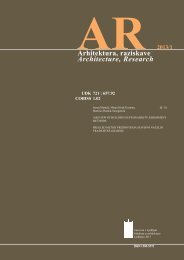Revija 2005/1 v PDF - Fakulteta za arhitekturo - Univerza v Ljubljani
Revija 2005/1 v PDF - Fakulteta za arhitekturo - Univerza v Ljubljani
Revija 2005/1 v PDF - Fakulteta za arhitekturo - Univerza v Ljubljani
You also want an ePaper? Increase the reach of your titles
YUMPU automatically turns print PDFs into web optimized ePapers that Google loves.
AR2oo5 / 1EditorialThe first issue of the <strong>2005</strong> volume is as usual divided intoarticles and a review of scientific research work with reportsabout presentations at congresses in 2004.Since our income of research resources in 2004 has increasedfrom 1 to 1.7 FTE, we have been witness to a somewhatdiminished quantity of research. The causes will have to beanalysed, but in any case, funds allocated to the Facultyaccording to the Agency for research activities of the Republic ofSlovenia's (ARRS) programme, will have to be redistributed andadapted to the research results. Following the OSIC control(Library of the Faculty for social sciences, responsible for thefield of social sciences) our Faculty's library respondedaccordingly by introducing a questionnaire, which is filled byauthors themselves, who are also responsible for the proposedentered qualification. The final entry will be controlled by OSICuntil the Scientific Council at ARRS decides upon common ruleswithin the COBISS system. More on the topic is described by ourcolleague Zupanèiè in her article. It is still our responsibility totake care of publishing and to collect citations: all are essential forevaluating scientific excellence of our research group.This time the articles are rather varied: from issues inplanning settlements to computer related topics. Two articlesintroduce one of the future topics: renewal, namely the article byLenko Pleština, our colleague from Zagreb, and rathersignificantly the young student Maša Kavèiè, who iscourageously entering the professional world by publishingissues from her field.In his article Peter Gabrijelèiè claims that transformations ofsocial and economic structures in the countryside are alsoconditioning transformations of spatial forms of landscape andsettlements. Changes are positive and negative, thereforedetailed measures for spatial management, which can beimplemented to provide quality directions for ongoing spatialtrends, have to be devised, with emphasis on management ofsmaller settlements.Alenka Fikfak argues that characteristics of settlementpatterns and forms are caught between stability and instability.They are assessed according to their historical values, albeit thattheir presently recognised image changed, adapted to the realityand transformed through centuries, meaning that it cannot bedistinguished in its original form.The new doctor of science Peter Marolt presents thestatement that when the form of an object's representation showsits conceptual ontological essence and extreme expression of theobject's identity, when we show the source, idea's structure andmodel of thought, when such representation impliestransformation of the visual (and tactile) world into pure abstractform, then we speak about the form of (representation ofarchitectural space as) an ideogram, but above all prove the tiebetween architecture and other disciplines of fine arts.Maša Kavèiè, a guest in the field of architecture, argues thatthe reasons for professional problems concerning legitimacy ofreconstruction in Slovenia lie in outdated conservationprinciples, legislature, as well as lack of interdisciplinarycooperation, incomplete documentation system, financialproblems, strict protection rules, more or less objectiveprofessional arguments and un-harmonised terminology ofprofessions involved with heritage protection.Lenko Pleština presents an introduction to one of the futuretopics by showing four examples of renewal, taken from hisbroad, rich and often awarded practise.A very specific theme is introduced by Gregor Èok, whopresents a classification of emerging spatial solutions, wherebyhe stresses the operational patterns of self-building practices andpoints out possibilities for regulating the processes at hand.Martina Zbašnik-Senegaènik continues her theme aboutmaterials. In European space four building techniques haveevolved, which are inherently different. The article showsparticular building techniques and their use in history.Iztok Kovaèiè, a young researcher involved with computers,claims that there is no central computer anymore for controllingactivities within a building but that there are computer chipsdistributed throughout the building, even in its smallestcomponents. All these small computers mutually interconnectinto a network.Tadeja Zupanèiè Strojan, has submitted an articlequestioning the evaluation of scientific work whereby data layersin 'ISI' databases were searched for, which distinguish specificsof the architectural profession worldwide and whose superficialacknowledgment is used by the productively most successfulsciences in Slovenia to argument their scientific excellence.The articles are followed by several reports about researchdone in 2004, all of which are available in the Faculty 's Library,and reports from congresses in 2004.Cheerful information is that the publisher EDUCA, whoprepared an exhibition of Slovene professional periodicalstogether with the Library France Bevk in Gorica, granted ARArhitektura raziskave / Architecture Research the secondprize for artistic execution of a magazine.I wish you pleasant reading.Editor5
















